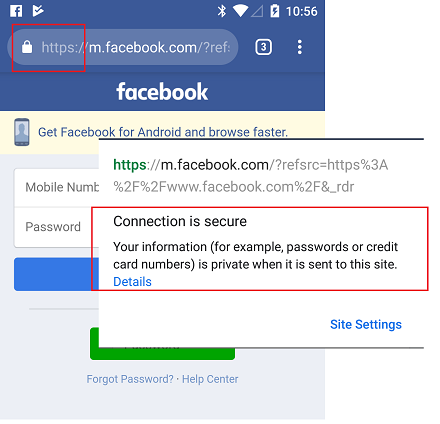PKI Tutorials - Herong's Tutorial Examples - v2.32, by Herong Yang
Visiting "https" Website with Chrome on Android Phone
This section provides a tutorial example on how to visit an HTTPS Website with Chrome on Android phone.
If you are using an Android phone, you probably spend lots of time with Chrome browser visiting Websites. So let's how Chrome on Android phone works with Websites that support the HTTPS protocol.
1. Run Chrome on your Android phone and enter "facebook.com" in the address area. The Facebook home page is displayed.
2. Look at the Website address area. You will see that a lock icon is displayed next to the address.
3. Tap on the lock icon, Information about the HTTPS connection is displayed.
Connection is secure Your information (for example, passwords or credit card numbers) is private when it is sent to this site.
Lock icon in the Web address area indicates that this page is secured with the HTTPS protocol. However, Chrome does not offer any function to let you view the details of the certificate used by server. You have to trust Chrome that it will validate the server certificate and use it encrypt all data exchanged between you and the server.

Table of Contents
Introduction of PKI (Public Key Infrastructure)
Introduction of HTTPS (Hypertext Transfer Protocol Secure)
Using HTTPS with Google Chrome
Using HTTPS with Mozilla Firefox
HTTPS with IE (Internet Explorer)
►Android and Server Certificate
►Visiting "https" Website with Chrome on Android Phone
"Your connection is not private" with Chrome on Android Phone
Viewing Server Certificate with Chrome on Android Phone
Viewing Server Certificate Path with Chrome on Android Phone
Trusted Certificate Store on Android phone
Downloading Trusted Root Certificate on Android phone
Installing Trusted Root Certificate on Android phone
Installing Website Server Certificate on Android Phone
Windows Certificate Stores and Console
RDP (Remote Desktop Protocol) and Server Certificate
macOS Certificate Stores and Keychain Access
Perl Scripts Communicating with HTTPS Servers
PHP Scripts Communicating with HTTPS Servers
Java Programs Communicating with HTTPS Servers
.NET Programs Communicating with HTTPS Servers
CAcert.org - Root CA Offering Free Certificates
PKI CA Administration - Issuing Certificates
Comodo Free Personal Certificate
Digital Signature - Microsoft Word
Digital Signature - OpenOffice.org 3